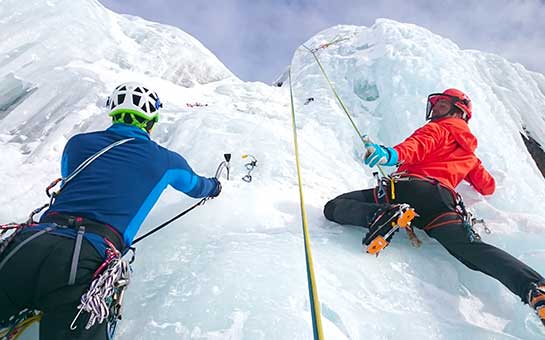The sport of ice climbing demands high fitness levels. This extreme sport involves climbing vertical, frozen surfaces like frozen waterfalls or glaciers. Ice as a surface is difficult to ascend because its form and consistency can change quickly—it’s brittle, it melts quickly, and (of course) it’s slippery. This adds the element of risk. It’s a no brainer, then, that if you’re planning on an ice-climbing excursion during your vacation, getting travel insurance for ice climbing is crucial.
Travel Insurance for Ice Climbing
Ice climbing injuries include deep lacerations due to fallen debris. The extreme weather conditions of the sport add to the risk of injuries. Investing in your safety by buying travel insurance for ice climbing is the right choice.
Most standard insurance plans don’t offer coverage for claims related to extreme sports like ice climbing. Be sure to read a plan’s certificate wording before purchase to ensure that it specifically covers ice climbing, and if it doesn’t, be sure to purchase hazardous sports travel insurance for ice climbing. The peace of mind is well worth the price, and it’s one less thing to worry about when you’re halfway up a glacier.
Basics of Ice Climbing
Ice climbing is the act of climbing ice formations. The activity qualifies as ice climbing only when the surface is vertical. Frozen waterfalls are probably the most difficult surfaces to surmount when attempting the sport.
Ice climbers scale these vertical surfaces using special equipment including ice-axes and crampons to help secure a solid footing. Since the weather is cold, climbers must wear several layers of clothing. Wearing the right gloves is also important—if the gloves aren’t flexible and don’t provide a good grip, it could cause problems.
One way of navigating the ice structures is by using a rope system. Thus, climbers will need to learn different kinds of knots and rope-work. These include placing, ice-screws, abseiling, and belaying. Types of ice also vary, so having a good understanding of the different types of ice is also important.
Climbing with a guide is crucial for newcomers to the sport. Taking on ice structures without prior experience can be dangerous. Many ice-climbing destinations offer beginner courses that require less effort as these rookies get their bearings.
Risks of Ice Climbing
Many people consider scaling ice structures because of the adrenaline rush it brings. Ice climbing is definitely considered one of the most dangerous sports for many reasons. First, ice climbing is hard on the body. You have to be in good physical shape to be an ice climber because the sport requires a lot of pulling strength.
The second reason is that the ice structures to be climbed are not always constant or sturdy. Climbers can lose their footing when the ice simply breaks away from under their feet. Some climbers have even broken limbs during a climb. Thus, as an ice climber, you have to be cautious about where you’re placing your foot, and knowledgeable about the qualities of the specific type of ice that you’re dealing with.
If the appropriate clothing is not worn, climbers could easily put themselves at the risk of frostbite. So, ensure that you are properly insulated before you expose yourself to the elements. Other risks of the sport include falling while climbing and being struck by falling debris. Depending on where people climb, avalanches are also a threat. The walk-ups on ice structures are difficult, and even experts prefer to take things slow and steady. It is important that you exercise patience when you go ice climbing.
These risks are real, and that’s why you must have ice climbing travel insurance. The types of injuries sustained during ice climbing require serious—and expensive—medical treatment. If you’re vacationing abroad, the last thing you want to deal with on top of being injured and navigating a foreign medical system is to have to pay the bill entirely out of your own pocket.
